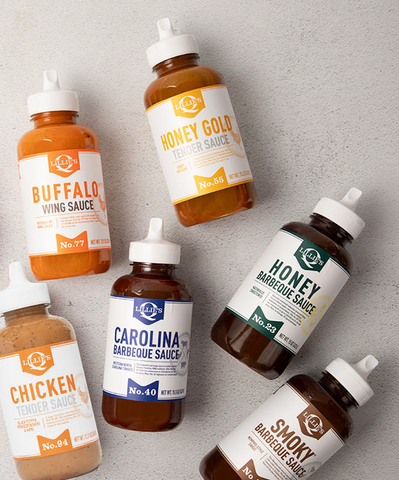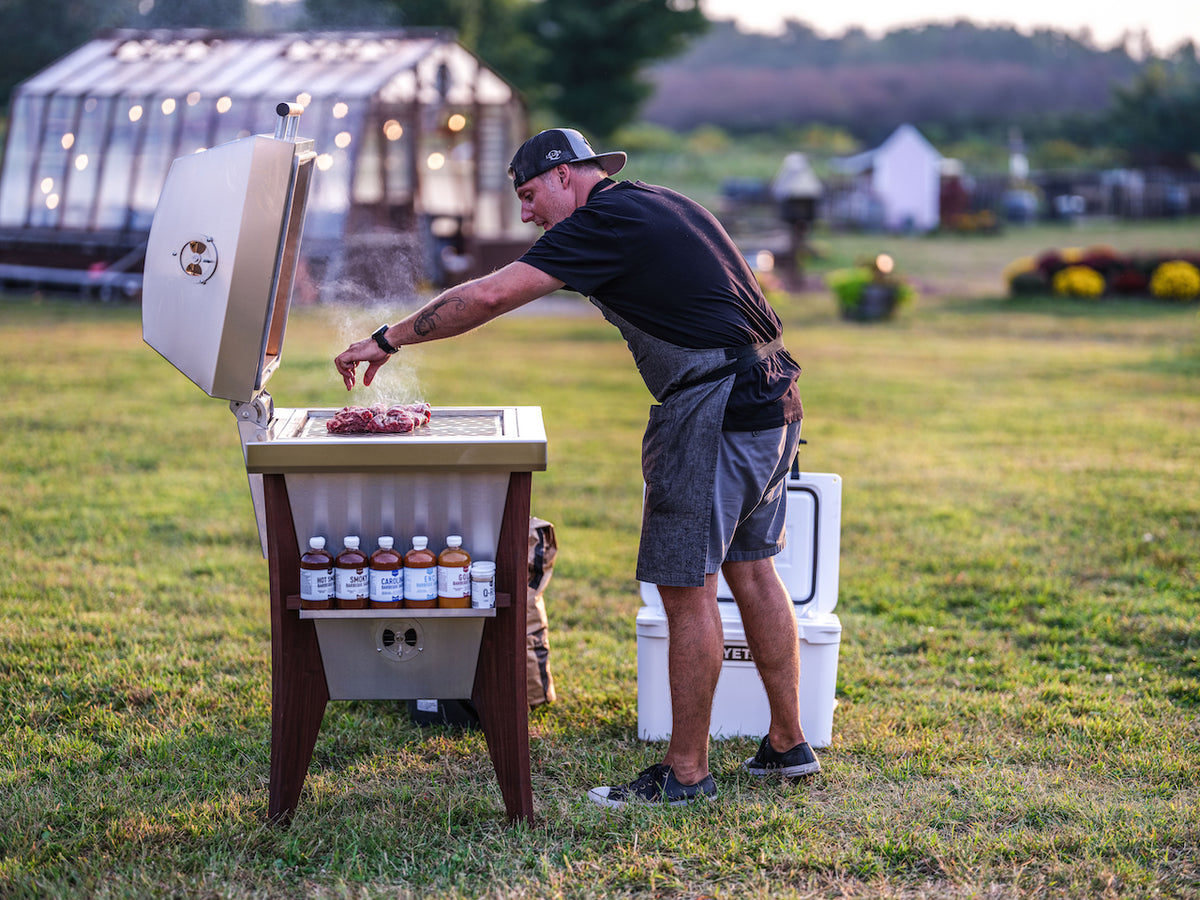There's nothing better than an outdoor cookout with friends and family. Think succulent meat grilled to perfection, drool-worthy sides like Szechuan peppercorn coleslaw, and good company. We can't think of anything that screams summer more.
Unless you cook BBQ competitively, you may not know the intricacies that separate barbequing, grilling, and smoking. You may even use these terms interchangeably, but they’re very different.
Read on to discover how to elevate your outdoor cooking game by learning the distinctions between these popular cooking methods.
The Ultimate Outdoor Cooking Showdown
People have been barbequing in America since before the United States came into existence. The term "barbeque" originally referred to a cooking appliance.
In 1526, Spanish explorer and writer Gonzalo Fernández de Oviedo y Valdez first used the term "barbacoa" to describe a frame of wood Indigenous peoples used to cook their meat. Today, when people hear the word "barbeque," they think of getting together to cook hotdogs and hamburgers outside.
Grilling and smoking are outdoor cooking methods that are commonly used at these social events.
A Quick Glance at Outdoor Cooking Methods
- Grilling means cooking hot and fast over a fire, regularly flipping it to avoid burning.
- Smoking refers to cooking something low and slow—with smoke.
- BBQ refers to the style of food (for example, Alabama-style BBQ) or the event where this food is served.
What Is BBQ?
BBQ isn't a cooking method—at least not when we talk about barbeque in the United States. Instead, you might go to a BBQ, where someone is flipping burgers and dogs or smoking something delicious.
It can also refer to a style of food. For example, if you were to stop into a Lillie’s Q restaurant, you might tell your friends that you went out for BBQ.
You can also get a little more specific with it. If you’re using a tomato-based vinegary sauce on your meat, you might say that you’re making Carolina barbeque. If you’re using a white mayo-based sauce like our Ivory Sauce, that’s Alabama BBQ. You can use this term to differentiate between regional specialties.
What Is Grilling?
The most common method when cooking outdoors, grilling is about cooking meat quickly using direct heat over a fire fueled by gas or charcoal. The thing that sets this popular method apart is the meat is cooked quickly over direct heat. This method gives food an outer sear and a little char while sealing in the juices and flavors of the meat.
Grilling is best for tender or thinner meats. You can also toss veggies on the grill for a quick cook with an extra punch of flavor.
You can also enjoy a great BBQ sauce on your grilled meats —just brush the sauce when the meat is almost finished since the sugar content could cause the meat to burn over high heat.
What Is Smoking?
Smoking involves cooking with the smoke from smoldering wood chips or chunks of hickory, cherry, or mesquite, each contributing its unique flavor.
Of the outdoor cooking methods, smoking occurs at the lowest temps to ensure the smoky flavor infuses into the meat while cooking it all the way through. If your smoker is too hot, the outer parts of your meat can cook too soon, resulting in a dry, flavorless bite. This method takes a long time, ranging from one hour to two weeks.
The Different Smoking Methods
There are two ways meat can be smoked: cold smoking and hot smoking.
Cold smoking is a commercial process performed in a smokehouse and exposes the meat to low temperatures, ranging from 68 to 100 degrees Fahrenheit. This technique is best reserved for cheese, fish, sausages, and veggies. After smoking, cold-smoked meats must be fully cured and cooked before eating. You likely won’t be attempting cold smoking at home any time soon.
Hot smoking is a conventional smoking process that uses a smoker. The meat is exposed to higher temperatures of 180 to 275 degrees Fahrenheit.
Unlike cold smoking, food cooked via hot smoking doesn't require additional cooking and can be eaten immediately.
Tips for Mastering Smoking
The most important part of learning how to smoke meat is learning how your smoker reacts. You need to maintain one consistent temperature in your machine and control the fire. This process may take trial and error to see what works for your specific smoker.
Remember that the more air a fire gets, the hotter it’s going to burn. This goes for both grilling and smoking, but it’s especially important when you’re pulling out the smoker. When working with your smoker, you’ll have to master when to open the vents to give the fire more air and when you need to cool things down.
Pro tip: Remember that weather affects temperature—wind and rain may affect how hot your fire burns.
Which Is Better for Beginners: Grilling or Smoking?
Grilling tends to be better for beginners because the equipment is less expensive. A Weber Kettle will only put you back around $100-200 while smoking equipment is much higher in price.
Smoking also requires a more nuanced understanding and control of fire. When you’re grilling, you’re moving the product around, while in smoking, you’re manipulating the fire to get the desired result.
Learning to grill first is a great way to learn how fire reacts to air and how to control temperatures. Once you master that, you can move on to smoking.
Grilling is also a shorter cooking method, so more people are used to it. You can pop a burger or a steak on the grill and have it ready relatively quickly, so it’s less of a commitment.
Which Is Better for Feeding a Large Group: Grilling or Smoking?
Once you master the art of smoking, it’s a better option for feeding large parties. This is because you’re usually smoking a larger piece of meat, like a large brisket or a whole rack of ribs.
When you’re smoking meat, you’ll also have more time to spend with your guests while the meat is smoking and resting. While grilling takes less time overall, most of that time is hands-on and requires your constant attention.
What Tools Are Useful To Have for Grilling and Smoking?
The right equipment can make all the difference when you’re learning to cook with fire. Here are some tools that will come in handy, whether you’re grilling or smoking.
- A thermometer: You’ll need this to ensure your meat is at the correct temperature. We like this model.
- Protective hot gloves: You’ll need these to mess with fire or grab hot pans
- Fire extinguisher: Hey, you never know what might happen!
Conclusion
Though barbequing, grilling, and smoking share some similarities, they're not the same. They all have distinctions that produce different flavor profiles.
Here at Lillie's Q, we're serving up Southern BBQ that's true to regional traditions while creating unique, reimagined flavors that are second to none. Thanks to our founder Chef Charlie McKenna's Grandmother Lillie and a commitment to the craft, we've mastered the art of BBQ. With our wide variety of sauces, flavorful rubs, and more, you’ll soon realize it's unlike anything you've ever tasted.
From pulled pork smoked low and slow over peach wood to hotlinks made with a unique savory blend of pork and beef, you can count on the Lillie's Q kitchen to do the cooking. Delivered from our kitchen to your door — just like that.
Sources:
Barbecue: What is it good for? | Irish Times
Curing and Smoking Meats for Home Food Preservation | NCHFP
Charcoal or Gas? Depends on What You’re Grilling (Published 2017) | NYTimes




